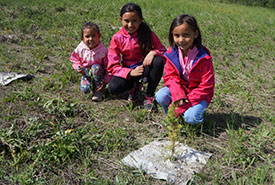Restoring our wild spaces

Children with tree at Trees for Bees 2 event (Photo by NCC)
At the Nature Conservancy of Canada (NCC), protecting Canada's natural areas and maintaining a diversity of native plant and animal life is our mission. Oftentimes, this is done by conserving wild habitat, but on sites that have been disturbed, one of the ways we can help restore these properties is by rewilding native habitats.
Ecological restoration is the process of helping natural areas recover from degradation and human impact. This isn’t just a local solution either; across the globe environmental degradation has reduced native plant and animal diversity.
In Canada, there are 454 species currently at risk of extinction. These include some of our iconic Canadian wildlife, like grizzly bear, burrowing owl and woodland caribou in Alberta.
Fortunately, damage to these species’ habitat can be reversed by careful restoration activities, such as planting trees, improving soil quality and protecting wildlife corridors.
Over the years, NCC has been involved in many restoration projects. In 2015, we partnered with the National Fish and Wildlife Federation to restore riparian areas on NCC-owned lands in Alberta. This project involved installing electric fences and off-site watering systems. These techniques force cattle to graze in designated areas, which results in a better distribution of livestock on the landscape and improved rangeland health by keeping them out of the riparian areas.
In the grasslands, we are working to restore habitat for many species at risk, including the greater sage-grouse. The Bell-Sage-Grouse Legacy Project is one example of a site which is surrounded by native grasslands in prime greater sage-grouse habitat. This property started as an agricultural field that had not been planted in approximately five years, and over the coming years NCC will undertake the restoration of this parcel of land, in collaboration with the Alberta Conservation Association and Alberta Environment and Parks, to ensure these rare birds continue to have somewhere to survive.
Currently, there are a number of projects happening across the province to reforest our conservation sites. Although waiting for trees to grow can be a very long process, watching the native plants and animals return to a formerly disturbed site is worth the effort!
Restoring and protecting native plant habitats will ensure the survival of the local wildlife that depend on them for food and shelter. Whether you’re supporting the work NCC does in natural spaces across the country or planting native flowers in your garden for local pollinators, everyone can have a role in supporting our native wildlife.




